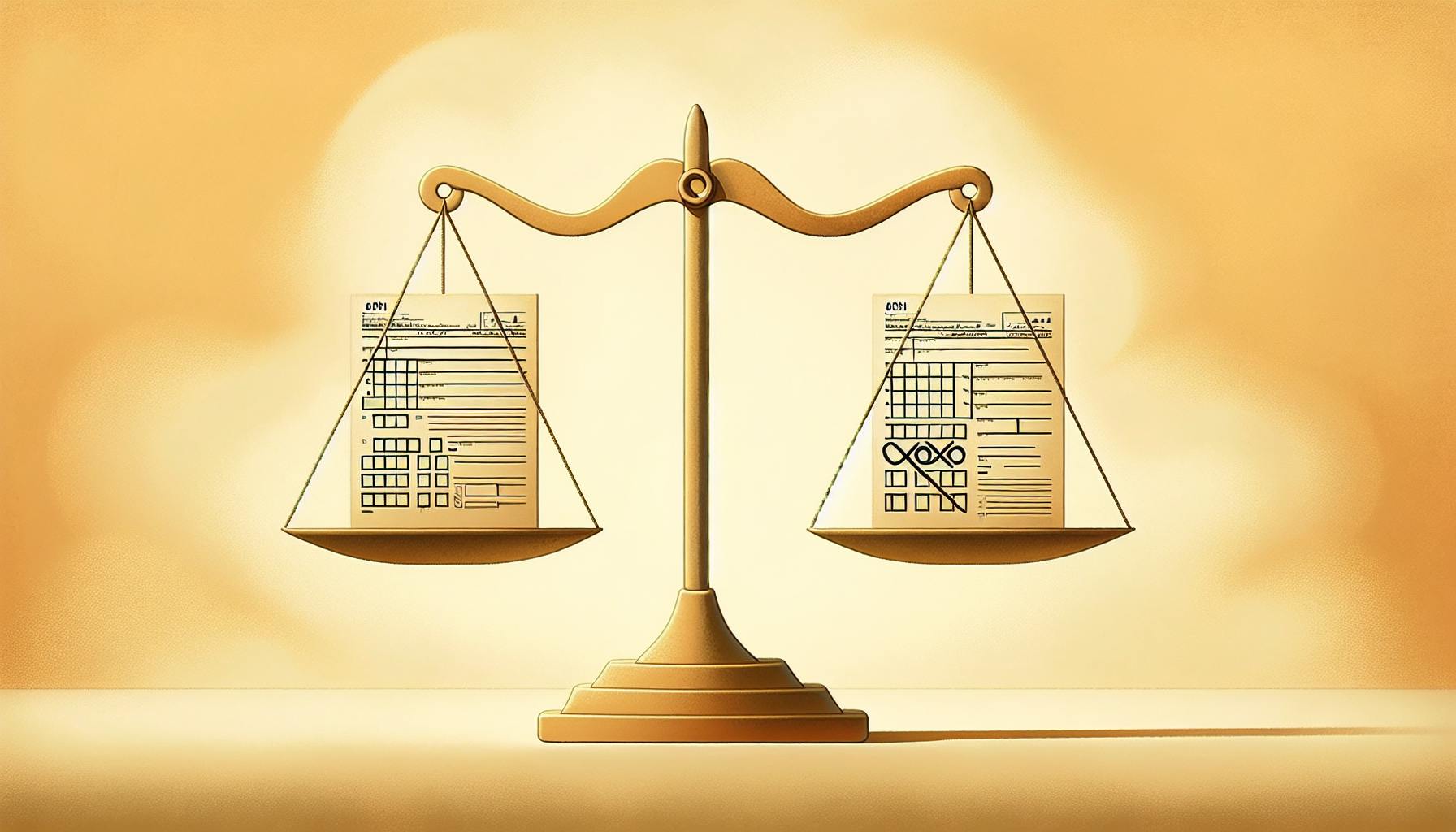Filing estimated taxes can be confusing and stressful for many taxpayers.
Luckily, this guide on filling out Form 1040-ES will walk you through calculating, paying, and avoiding penalties for estimated taxes in clear, easy-to-understand steps.
You'll learn key concepts like safe harbor rules, the 110% rule, what estimated tax actually is, and more. You'll also get recommendations on free IRS resources, online calculators, and when to seek professional help. By the end, you'll feel confident you're meeting all requirements for estimated payments and avoiding any penalties.
Introduction to Estimated Tax for Individuals
Form 1040-ES is used to calculate and pay estimated tax. Estimated tax payments are made by certain individuals, such as self-employed workers, gig economy workers, investors, or those with income not subject to withholding. Making estimated tax payments helps avoid penalties for underpayment when filing your annual tax return.
Understanding estimated taxes is key for proper tax planning and compliance in 2023.
Understanding Form 1040-ES and Estimated Tax Payments
Form 1040-ES is an IRS form used to calculate and pay estimated tax throughout the year. Estimated tax refers to income tax payments made during the current year to pay tax on income not subject to withholding, such as self-employment income, gig work income, investment income, taxable Social Security benefits, and income from rental properties.
By making estimated payments, taxpayers can pay their tax liability over the course of the year rather than owing a large amount when they file their tax return. Form 1040-ES helps taxpayers determine how much they should pay each quarter to avoid penalties.
Identifying Taxpayers Required to Make Estimated Tax Payments
The most common categories of taxpayers required to make estimated tax payments are:
- Self-employed individuals and independent contractors
- Gig economy workers such as rideshare drivers or Airbnb hosts
- Investors with taxable interest, dividends, or capital gains
- Retirees with investment income or taxable retirement account distributions
- Owners of rental properties
- Partners in partnerships or shareholders in S corporations
Essentially, if you have income not subject to withholding, you may need to pay estimated tax to avoid penalties when you file your annual return. Checking your prior year tax return and using the estimated tax worksheets can help determine if estimated payments are required.
How do you calculate total estimated tax?
To calculate your total estimated tax for the year, follow these steps:
-
Estimate your total taxable income for the year - This includes income from wages, self-employment, interest, dividends, capital gains, rental property, etc.
-
Calculate your total tax on that income - Use the tax tables, tax rate schedules, or tax calculation tools to figure out your total tax based on your total taxable income. This should account for income tax brackets, deductions, exemptions, credits, alternative minimum tax, self-employment tax, etc.
-
Subtract any tax credits and withholding - Subtract any estimated tax credits you expect to claim, like the child tax credit. Also subtract any federal income tax you expect to have withheld from wages, pensions, etc. The remainder is your estimated tax.
-
Divide by 4 to calculate each quarterly payment - Take your total estimated tax and divide it by 4. This amount must be paid each quarter in estimated tax payments to avoid penalties.
So in summary, estimating your total income, calculating total tax, subtracting credits/withholding, and dividing by 4 quarters gives you the amount you need to pay for each estimated quarterly tax payment. Use IRS Form 1040-ES and its worksheet to help calculate this or try an online 1040-ES calculator.
What is Form 1040 ES estimated tax?
Form 1040-ES is used to calculate and pay estimated tax. Estimated tax refers to income tax you pay yourself during the year, as opposed to having tax withheld from your paycheck.
You may need to pay estimated tax if you have income that is not subject to withholding, such as:
- Self-employment income
- Interest and dividends
- Rental income
- Alimony
- Income from partnerships, S corporations, estates, or trusts
By paying estimated tax during the year, you avoid having a large tax bill when you file your return. You may also avoid penalties for underpayment of estimated tax.
To figure your estimated tax, you can use the worksheet provided with Form 1040-ES. This helps you estimate your expected income, deductions, exemptions, credits, and tax for the year. From there, you can calculate how much estimated tax to pay each quarter.
The estimated tax is typically paid in four equal installments on April 15, June 15, September 15, and January 15. You can pay online, by phone, or by mail. Paying online through IRS Direct Pay or the Electronic Federal Tax Payment System (EFTPS) is the easiest method.
So in summary, Form 1040-ES helps you calculate and pay tax on income not subject to withholding during the year. This prevents a large balance due at tax time and possible underpayment penalties.
What is the 110% rule for estimated tax payments?
The IRS requires individuals to pay taxes throughout the year, either through tax withholding or by making estimated tax payments. If you don't pay enough tax during the year, you may have to pay an underpayment penalty when you file your tax return.
To avoid the underpayment penalty, the IRS has the "100 percent of your previous year's tax" rule. This means you should pay at least 100% of the tax shown on your return for the prior year.
However, if your adjusted gross income for the prior year was over $150,000 ($75,000 if married filing separately), you have to pay 110% of the previous year's tax. This is known as the 110% rule.
For example, if you had $160,000 of AGI on your 2021 tax return and owed $20,000 in federal tax, you would need to pay at least 110% x $20,000 = $22,000 in estimated taxes for 2022 to avoid the penalty.
The 110% rule ensures that higher-income taxpayers, who often have greater variability in their income, pay enough tax throughout the year. Paying 110% of your prior year's tax liability is the safest way to avoid an underpayment penalty if you earn over $150,000.
You can use IRS Form 1040-ES and its worksheet to calculate your required estimated tax payments based on 110% of last year's tax. The form helps determine if you need to make estimated payments to comply with the 110% rule.
What is the 90% rule for estimated taxes?
The 90% rule for estimated taxes refers to the requirement that individuals must pay at least 90% of their total tax liability through tax withholding and/or estimated tax payments to avoid an underpayment penalty.
Specifically, the rule states that you must pay at least 90% of the tax shown on your current year's tax return or 100% of the tax shown on your prior year's tax return, whichever is smaller. This is known as taking the "safe harbor" to avoid penalties.
For example, if your 2022 total tax liability ended up being $10,000, then you would have needed to pay at least $9,000 (90% of $10,000) through withholding and/or estimated payments by the end of 2022. If you had instead paid 100% of your 2021 total tax liability, and that amount was less than 90% of your 2022 liability, you could take the safe harbor and would not owe a penalty.
The 90% rule is designed to ensure that individuals pay their income taxes evenly throughout the year, rather than waiting to pay everything at tax time. Paying as you earn income during the year also helps ensure that the government has a steady stream of tax revenue to fund operations.
If you fail to pay at least 90% of your total tax through withholding and estimated payments, you may be subject to an underpayment penalty when you file your tax return. The IRS Form 2210 is used to calculate any penalty owed.
sbb-itb-beb59a9
Calculating Your 2023 Estimated Taxes Using Form 1040-ES
Form 1040-ES is used to calculate and pay estimated tax owed on income that is not subject to withholding, such as self-employment income, dividends, interest, rents, and capital gains.
The 2023 estimated tax worksheet in Form 1040-ES helps determine how much you need to pay each quarter to avoid penalties when you file your 2023 tax return.
Navigating the 2023 Estimated Tax Worksheet
The 2023 estimated tax worksheet walks through the following steps to calculate required estimated tax payments:
- Estimate your adjusted gross income for 2023
- Calculate your 2023 tax by applying tax rates and brackets
- Determine total tax credits and deductions to subtract
- Calculate self-employment tax owed
- Determine how much tax will be withheld from other income sources
- The remaining amount is your estimated tax owed
This final amount is then divided evenly by four to calculate how much should be paid for each estimated tax quarterly payment deadline in 2023.
Determining Your Effective Tax Rate
To accurately estimate taxes owed, determine your effective tax rate by:
- Identifying all sources of 2023 taxable income: salaries, self-employment income, taxable interest and dividends, capital gains, rental income, etc.
- Researching how much of your income will fall under each 2023 IRS tax bracket
- Factoring in tax deductions and credits you plan to claim which will reduce taxable income
This provides the effective tax rate to apply against total 2023 income for estimating taxes owed.
Accounting for Credits and Deductions
Tax credits such as the Foreign Tax Credit, Retirement Savings Contributions Credit, and General Business Credit directly reduce taxes owed.
Factor any credits into Line 5 of the 1040-ES worksheet when calculating estimated taxes due.
Other deductions like self-employment expenses reduce taxable income, so account for them when initially estimating 2023 adjusted gross income.
Estimating Self-Employment Tax
As a self-employed individual, you must pay self-employment (SE) tax on net earnings.
When filling out the 1040-ES worksheet, calculate Schedule SE tax separately then include in Line 4. Pay this additional tax when making 2023 estimated payments to avoid penalties.
Refer to IRS Publication 505 for more guidance on calculating estimated taxes with self-employment income.
Making Quarterly Estimated Payments for 2023
Choosing a Payment Method
You have several options for making your quarterly estimated tax payments to the IRS for 2023:
-
IRS Direct Pay: This free service allows you to securely pay your estimated taxes directly on IRS.gov. You can pay immediately or schedule payments up to 30 days in advance. Direct Pay accepts debit and credit cards as well as checking or savings account transfers.
-
Electronic Federal Tax Payment System (EFTPS): With EFTPS you can pay your estimated taxes online or by phone. You'll need to enroll first. Once set up, you can schedule one-time or recurring tax payments.
-
IRS2Go Mobile App: IRS2Go provides a quick option to pay your 1040-ES estimated taxes on-the-go directly from your mobile device.
-
Check or Money Order: You can choose to mail in a payment by check or money order using the payment vouchers that come with Form 1040-ES. Be sure payments are postmarked by the deadline.
Understanding Payment Deadlines
To avoid penalties, be sure to make payments by the following deadlines in 2023:
- April 18, 2023
- June 15, 2023
- September 15, 2023
- January 16, 2024
Payments can be made early but no later than January 16, 2024. Calculate your estimated payments carefully as penalties can apply if you've underpaid.
Utilizing Electronic Payment Options
The IRS offers secure and convenient online and mobile options for paying your estimated quarterly taxes electronically:
-
IRS.gov/Payments: Choose Direct Pay or debit/credit card payments. Schedule one-time or recurring payments.
-
IRS.gov/Account: Log into your IRS account to view balance, make a payment, set up installment plans.
-
EFTPS: Enroll to schedule and manage tax payments year-round. Can store bank account, credit card, or enrollment in installment agreement.
-
IRS2Go Mobile App: Pay 1040-ES estimated taxes on-the-go from your iOS or Android device.
Leveraging electronic payment methods can save time and give you more control over managing estimated tax obligations.
Paying Estimated Taxes for Pass-Through Businesses
If you have income from a pass-through entity like an LLC or S-corporation, you may need to pay estimated taxes on that business income. The IRS requires quarterly estimated tax payments if you expect to owe $1,000 or more.
Use Form 1040-ES to calculate your share of business income and related self-employment taxes. Report that pass-through income on your personal Form 1040 tax return. Payments can be made via check, money order, or electronically using EFTPS, Direct Pay, IRS2Go, etc.
Be sure to understand your total tax liability from all sources of income to determine if estimated payments are required to avoid penalties.
Avoiding Penalties for Underpayment of Estimated Taxes
Explain the safe harbor rules, how to calculate exceptions, and how much is the penalty for not paying estimated taxes on time.
Understanding Safe Harbor Rules for 2023
The safe harbor rule allows you to avoid penalties for underpayment of estimated taxes if you pay at least 90% of your total tax liability or 100% of your prior year's tax liability (110% if your adjusted gross income exceeds $150,000). The thresholds are increased slightly for the 2023 tax year.
To qualify for the safe harbor exception in 2023:
- You must pay at least 90% of your total 2023 tax liability
- Or 100% of your total 2022 tax liability
- Or 110% of your 2022 tax liability if your 2022 AGI exceeded $150,000
As long as you meet one of the above thresholds through estimated payments or withholding, you can avoid underpayment penalties.
Applying the Annualized Income Installment Method
The annualized income installment method is another way to calculate an exception to underpayment penalties if your income varied significantly over the year.
To use this method, you must annualize your income, deductions, and credits for each period. Then calculate the tax due on the annualized amounts and compare it to your actual estimated payments to determine if you qualify for the exception.
It involves complex calculations, so most taxpayers should consult a tax professional before attempting this method.
Calculating Underpayment Penalties
If you did not pay enough estimated taxes to meet one of the safe harbor rules, you may have to pay an underpayment penalty. This is calculated as interest on the unpaid amount, currently at a rate of 6% annually.
The penalty is calculated based on the number of days that the estimated tax payment was late. The IRS provides worksheets and guidance to calculate the penalty in Form 2210.
In some cases, the IRS may waive the penalty if you can show reasonable cause for underpayment. But in general, taxpayers who owe $1,000 or more in tax should make estimated payments to avoid penalties. Consulting a tax professional can help determine the right amount to pay.
Resources and Assistance for Calculating and Paying Estimated Taxes
Leveraging IRS Tools and Publications
The IRS provides several useful tools and informative publications to assist taxpayers with estimating their taxes and making payments:
-
The IRS Tax Withholding Estimator helps determine if you are having the right amount of tax withheld from your paycheck. Using this tool can help avoid penalties for underpayment of estimated taxes.
-
Publication 505, Tax Withholding and Estimated Tax offers detailed guidance on estimated taxes, including calculation worksheets and examples. This publication explains the estimated tax requirements, penalties, and how to adjust your payments.
-
Form 1040-ES contains an estimated tax worksheet to calculate required payments. The form includes payment vouchers to submit with checks or money orders.
Seeking Professional Tax Help
Getting help from a tax professional can simplify estimating taxes owed and ensure timely, accurate payments:
-
CPAs and Enrolled Agents have expertise in tax planning and preparation. They can review your situation, estimate tax liability, recommend appropriate payment amounts, and file returns.
-
Pros can advise on deductions, credits, and other ways to potentially lower tax bills. They stay updated on the latest tax law changes.
-
Fees vary based on the complexity of your tax situation. Shop around to find affordable help that meets your needs.
Where to Find and Obtain Form 1040-ES
You can get Form 1040-ES along with other useful IRS forms and publications from the following sources:
-
Download directly from the IRS Forms and Publications page on IRS.gov.
-
Call 800-TAX-FORM to ask questions and request forms by mail.
-
Visit an IRS Taxpayer Assistance Center in-person to obtain forms and speak with an IRS representative.
-
Use IRS2Go mobile app to view, download, and order forms.
Exploring Online Calculators
Online estimated tax calculators can provide quick estimates to give you an idea of taxes owed. Some things to consider with these tools:
-
Answer questions accurately for the best estimate. Entering incorrect info will skew results.
-
Most only estimate federal tax owed. You still need to account for state taxes.
-
Use calculators as a starting point. Adjust payments later if your situation changes.
-
Free calculators offer basic functionality. Paid tools often provide more detailed estimates.
Conclusion: Key Takeaways on Estimated Tax Payments
Calculating and paying estimated taxes can seem complicated, but following these key steps will help individuals estimate their tax liability and make timely payments to avoid penalties:
-
Use IRS Form 1040-ES and its worksheet to calculate estimated taxes owed based on income sources. Account for self-employment taxes.
-
Make equal installment payments by the IRS deadline dates using electronic payment options like IRS Direct Pay, EFTPS, or the IRS2Go app.
-
Update estimated tax payments if income or tax situations change to avoid underpayment penalties. Use the IRS Tax Withholding Estimator.
-
Review IRS Publication 505 for detailed guidance on estimated taxes. Consult a tax professional with any questions.
Accurately calculating and paying quarterly estimated taxes is crucial for meeting 2023 tax obligations. Following the recommendations above will help individuals determine estimated tax liability, make timely payments, and avoid costly penalties.




